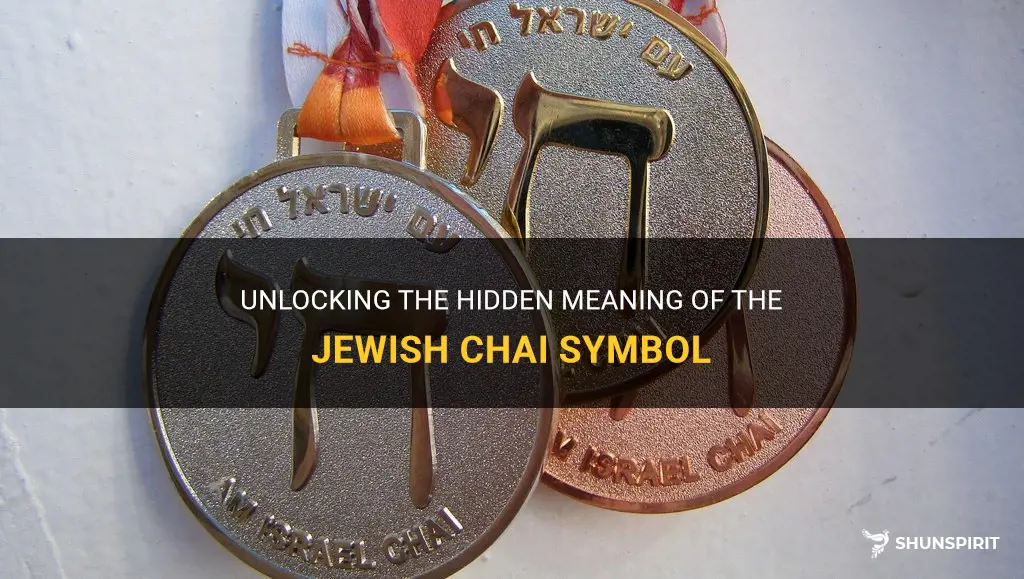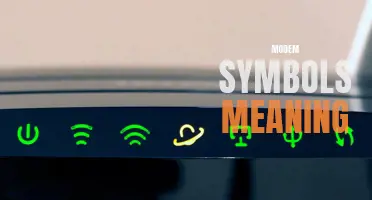
The Jewish Chai symbol, with its unique combination of Hebrew letters, holds a deep and profound meaning within the Jewish faith. Translated as life or living, Chai symbolizes the vitality and sanctity of existence in Jewish culture. This symbol has endured through centuries, speaking to the resilience and endurance of the Jewish people. Its multifaceted symbolism carries both religious and cultural significance, making it a cherished emblem of Jewish identity and a powerful reminder of the beauty and value of life.
What You'll Learn
- What is the meaning of the Jewish Chai symbol?
- How is the Jewish Chai symbol traditionally represented?
- What is the significance of the number 18 in Jewish culture and how does it relate to the Chai symbol?
- Are there different interpretations or variations of the Chai symbol within Jewish communities?
- How is the Chai symbol incorporated into Jewish art and jewelry?

What is the meaning of the Jewish Chai symbol?
The Jewish Chai symbol, also known as the Chai symbol, is of great importance in Jewish culture. It is a symbol that carries a lot of significance and represents various aspects of Jewish life and faith. The word "Chai" translates to "life" in Hebrew, and the symbol itself is shaped like the Hebrew letter "Chet" (ח) with a small Yud (י) inside of it.
The Chai symbol is often seen on jewelry, art, and other items in the Jewish community. It is considered a powerful symbol that is believed to bring good luck, positive energy, and protection to those who wear or display it. In fact, it is quite common to see people wearing jewelry with the Chai symbol as a talisman or amulet.
The Chai symbol is also associated with the concept of "l'chaim," which translates to "to life." This phrase is often used as a toast when celebrating joyful occasions or during special ceremonies. It is a reminder to appreciate and cherish life and to live it to the fullest.
In Jewish numerology, each Hebrew letter is assigned a numerical value. The Chet letter in the Chai symbol has a numerical value of 8, and the Yud inside it has a value of 10. Together, they add up to 18, which is considered a very lucky number in Jewish culture. In fact, giving monetary gifts in multiples of 18 is seen as a symbol of good luck and blessings for the recipient.
The Chai symbol also holds religious and spiritual significance. It is a reminder of the Jewish belief in the sanctity of life and the importance of living a fulfilling and meaningful existence. It is a symbol that reflects the Jewish emphasis on the value and worth of every individual life.
In addition, the Chai symbol is often associated with Jewish tradition, customs, and rituals. It can be found on items used in religious ceremonies, such as Torah covers, prayer shawls, and mezuzahs. Its presence serves as a reminder of the rich heritage and deep-rooted traditions of the Jewish faith.
Overall, the Jewish Chai symbol is more than just a decorative motif. It represents the essence of Jewish life and serves as a powerful symbol of blessings, luck, and the celebration of life itself. Whether worn as jewelry or displayed in the home, the Chai symbol is a meaningful reminder of the values and beliefs of the Jewish community.
Unraveling the Deeper Meaning of the Gye Nyame Symbol
You may want to see also

How is the Jewish Chai symbol traditionally represented?
The Jewish Chai symbol is traditionally represented as a symbol consisting of two Hebrew letters: Chet (ח) and Yod (י). The Chet symbol looks like a closed loop with a vertical line descending from its center, while the Yod symbol looks like a small apostrophe or a dot. When combined, these two letters form the word "Chai," which means "life" in Hebrew.
The Chai symbol holds significant meaning in Jewish culture and is often used as a symbol of good luck, protection, and longevity. It is commonly found in various forms of Jewish artwork, jewelry, and religious items.
The Chai symbol is believed to have originated from Jewish mysticism, particularly from the study of Kabbalah. In Kabbalistic teachings, the Chai symbol represents the eternal life force that flows through all living beings. It is seen as a reminder to cherish and appreciate the gift of life and to live it to the fullest.
The symbol can be found in different variations, but the most common representation is the Hebrew letters Chet and Yod combined in a stylized manner. It is often depicted in jewelry, such as necklaces, bracelets, and rings, with the letters arranged vertically or horizontally. The symbol is also frequently incorporated into mezuzahs, which are small cases containing sacred Jewish texts that are affixed to the doorposts of Jewish homes.
In addition to its aesthetic and decorative use, the Chai symbol also has a deeper spiritual meaning for many Jews. It serves as a source of inspiration, reminding individuals to embrace life, find joy in everyday experiences, and strive for a meaningful existence.
The Chai symbol is not only significant to individuals of Jewish faith but also holds value for those seeking to connect with Jewish culture and heritage. Its universal message of celebrating life and seeking its true essence resonates with people of all backgrounds.
In conclusion, the Jewish Chai symbol is traditionally represented as a combination of the Hebrew letters Chet and Yod. It symbolizes life, eternity, and the vitality of the human spirit. Whether worn as jewelry or displayed in religious items, the Chai symbol serves as a reminder of the importance of cherishing and appreciating life's blessings.
Exploring the Symbolic Meanings behind Baby Brezza Symbols
You may want to see also

What is the significance of the number 18 in Jewish culture and how does it relate to the Chai symbol?
The number 18 holds special significance in Jewish culture and is considered a symbol of good luck and life. In Hebrew, the number 18 is represented by the letters "Chai," which means "life." This association between the number 18 and the Chai symbol has deep roots in Jewish tradition.
The Chai symbol consists of the letters Chet (ח) and Yud (י), which together form the word Chai (חי). In Hebrew, each letter also has a numerical value, and Chet is assigned the value of 8, while Yud is assigned the value of 10. When combined, these two letters add up to 18, making the Chai symbol a visual representation of the number 18.
The significance of the number 18 can be traced back to the Jewish concept of gematria, which assigns numerical values to Hebrew letters. This practice allows words or phrases to be interpreted in terms of their numerical equivalent. In gematria, the number 18 is associated with the Hebrew word "chai," which means "life." The number 18 is considered to be a symbol of good luck and blessings, as well as a representation of the divine essence of life itself.
In Jewish culture, the number 18 is often considered a powerful and meaningful number. It is frequently used in celebrations and rituals, such as bar/bat mitzvahs, weddings, and other joyous occasions. When attending a Jewish wedding, it is customary to give monetary gifts in multiples of 18, symbolizing a wish for a long and prosperous life for the newlyweds.
Additionally, the number 18 is used in blessings and prayers. For example, the Amidah, a central prayer in Jewish liturgy, consists of 18 blessings. Each blessing addresses a specific aspect of life, such as health, peace, or wisdom. By incorporating the number 18, these blessings express a desire for abundance and fulfillment in various areas of life.
The Chai symbol is often worn as jewelry or displayed in homes as a symbol of protection, good luck, and a reminder of the importance of life. It can be seen on necklaces, bracelets, and rings, and is commonly given as a gift on special occasions. The Chai symbol serves as a constant reminder to embrace life and to appreciate the blessings that it brings.
In conclusion, the number 18 holds significant meaning in Jewish culture as a symbol of life and good luck. The association of the Chai symbol with the number 18 further emphasizes this connection. The Chai symbol is not only a visual representation of the number 18 but also serves as a powerful reminder to cherish life and the blessings it brings.
Unveiling the Hidden Symbolism and Meaning of Mushrooms
You may want to see also

Are there different interpretations or variations of the Chai symbol within Jewish communities?
The Chai symbol, which means "life" in Hebrew, is a potent and popular symbol within Jewish communities. It is commonly worn as a pendant, displayed on walls, or incorporated into other forms of Judaic art. However, despite its widespread usage, there are different interpretations and variations of the Chai symbol within Jewish communities. These variations reflect the diverse range of beliefs and traditions within the Jewish faith.
One common variation of the Chai symbol is its artistic representation. While the basic shape of the symbol consists of two Hebrew letters, "chet" (ח) and "yud" (י), connected together, the artistic styles in which these letters are depicted can vary. Some interpretations use a simple, straight-line design, while others incorporate more elaborate and ornate embellishments. These artistic variations can differ across different regions and communities, reflecting the unique cultural aesthetics of each group.
Another variation of the Chai symbol lies in its numerical representation. In Hebrew, each letter has a numerical value. The letter "chet" corresponds to the number 8, and the letter "yud" corresponds to the number 10. To get the numerical value of Chai, you add these two numbers together, resulting in the number 18. As a result, the number 18 holds special significance in Jewish culture, as it is often associated with good luck and blessings. Therefore, the Chai symbol is sometimes used to represent the number 18, and it is not uncommon to see Jewish charitable donations or gifts given in denominations of 18.
Additionally, the Chai symbol can be interpreted in the context of Jewish mysticism and Kabbalah. In Kabbalistic teachings, the number 18 is seen as being connected to the concept of "chai" or "living." According to Kabbalah, the combination of the letters "chet" and "yud" in the Chai symbol represents a connection between the physical and spiritual realms, symbolizing the presence of the divine within the material world.
Furthermore, the Chai symbol can also have personal and individual interpretations. For some, wearing or displaying the Chai symbol signifies a commitment to the value of life and an affirmation of one's Jewish identity. It can also serve as a reminder to live a meaningful and purposeful life, in line with Jewish teachings and values.
In conclusion, while the Chai symbol holds a universal meaning of "life" within Jewish communities, there are different interpretations and variations of the symbol across different regions, traditions, and belief systems. These variations can be seen in the artistic representation, numerical value, mystical interpretations, and personal symbolism associated with the Chai symbol. Ultimately, these differences highlight the richness and diversity of Jewish culture and its interpretation of key symbols and concepts.
The Hidden Meanings of Chinese Symbol Tattoos Behind the Ear
You may want to see also

How is the Chai symbol incorporated into Jewish art and jewelry?
The Chai symbol, also known as the symbol of life, is an important symbol in Jewish culture and is often incorporated into art and jewelry. The symbol consists of the Hebrew letters "Chet" (ח) and "Yod" (י), which together spell the word "Chai" in Hebrew. In Jewish tradition, the word Chai means "life" and holds a deep significance.
One of the most common ways the Chai symbol is incorporated into Jewish art and jewelry is through the use of a Chai pendant. These pendants are often worn as a symbol of good luck and protection, and they serve as a reminder to live life to the fullest. Chai pendants can be found in various designs, ranging from simple and understated to intricate and ornate. They are typically made from precious metals such as gold or silver and may be adorned with gemstones or intricate engravings.
The Chai symbol is also commonly incorporated into Jewish artwork. It can be found in paintings, sculptures, and other forms of artistic expression. In these works, the Chai symbol may be used to represent the concept of life, the divine presence, or the enduring nature of the Jewish people. The symbol is often placed in prominent positions or integrated into larger designs, serving as a focal point or a source of inspiration.
In addition to jewelry and artwork, the Chai symbol can be found in various other forms of Jewish expression. It may be embroidered onto clothing, engraved onto ritual objects, or used as a motif in synagogue decor. The widespread use of the Chai symbol in Jewish culture and art is a testament to its importance and the significance it holds within the community.
In conclusion, the Chai symbol is deeply rooted in Jewish tradition and is often incorporated into art and jewelry. It serves as a symbol of life and is believed to bring good luck and protection. Whether worn as a pendant, displayed in artwork, or incorporated into other forms of Jewish expression, the Chai symbol holds a special place in Jewish culture and serves as a reminder to live life to the fullest.
A Comprehensive Guide to Hyundai Accent Dashboard Symbols and Meanings
You may want to see also
Frequently asked questions
The Jewish Chai symbol, often represented by the combination of the Hebrew letters "Chet" and "Yud," is a symbol that signifies life or living. In Hebrew, the word "Chai" means "alive" or "living," and the Chai symbol is commonly associated with blessings, good luck, and protection.
In Hebrew, the word "Chai" is pronounced as "khah-ee" or "khay." The "Chet" (ח) sound is a guttural sound similar to the "ch" sound in "Bach," and the "Yud" (י) sound is pronounced like a short "ee" sound.
While the Jewish Chai symbol is often associated with the concept of life, it is not directly related to the Tree of Life in Jewish symbolism. The Tree of Life represents the interconnectedness of all living beings, while the Chai symbol specifically focuses on celebrating and honoring individual life.
The Jewish Chai symbol is not tied to any specific occasions or rituals. However, it is commonly seen in various forms of Jewish art, jewelry, and decorations. Many people choose to wear or display the Chai symbol as a reminder of the importance of life and as a symbol of their Jewish identity.
Yes, the Jewish Chai symbol is often seen as a protective amulet. It is believed to bring blessings, good luck, and protection to the wearer or those who display it. It is not uncommon to see the Chai symbol engraved on jewelry, mezuzahs (doorpost ornaments), and other items used for spiritual protection.







